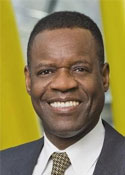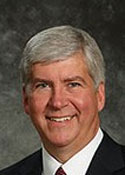Detroit has to diet to survive
Kevyn Orr has plenty of numbers he has to confront in his new role as emergency manager of Detroit.
One of the more critical ones, though, may not have his immediate attention.
As of the 2010 Census, which is already outdated given facts on the ground that change daily, Detroit had 269,445 occupied housing units within its 139 square miles -- or 1,938 units per square mile.
For comparison, Denver had 5,733 units per square mile; Boston, 5,166; Pittsburgh, 2,436; Minneapolis, 2901. In New York, the figure was 9,836.
For every 3.4 occupied housing units in Detroit, there was one vacant unit; 79,725 vacant units in all. In fact, Detroit had more vacant units than Grand Rapids (Michigan’s no. 2 city) had occupied units.
Unfortunately for Detroit, the forms of disaster that can compel Congress to appropriate $60 billion in relief funding just weeks following, say, Hurricane Sandy, do not include decades of economic despair. If you wanted to see the long-term effects of a major hurricane in which FEMA didn’t exist, large expanses of Detroit would probably be a good place to visit.
All of which could be considered beside the point given the historic change Detroit is going through.
Without an emergency manager, or Republican lawmakers turning into New Dealers, Detroit was destined for bankruptcy. Now it doesn’t have to be. Council members and labor leaders who clearly didn’t want to tell their constituencies that painful sacrifice was going to be required now don’t have to.
That’s the point of statutorily providing Gov. Rick Snyder and Orr with so much leverage.
National media paired Orr's appointment with the bleak reminders of Detroit's 20 square miles of vacant land and the Packard Plant. An optimist could view it in the same positive light as the economic transformation of 7.2 square miles of Midtown, downtown, Rivertown, Corktown, Eastern Market and Lafayette Park – all being powered through entrepreneurship, private investment and public works.
Density is being restored in the city’s historic core. Last month’s study of the central city by the Hudson-Webber Foundation reported that, since 2006, $6 billion is being invested. In 2012, more than 97 percent of the available rental units in Midtown and downtown were occupied.
All the capital being expended in Detroit, however, will be diluted, absent an integrated plan that provides the political, financial and legal means for dealing with the city’s biggest challenge: Its sheer, unmanageable size and the residue of what once was.
Balance all the budgets you want, but there still won’t be the tax base to support providing police patrols, firefighting, street lighting, street repair and trash service on such an inefficient basis. Attempting to do so merely robs services from higher density areas in which residents are unfairly subsidizing neighborhoods where the numbers can no longer be justified. The absence of public investment in reclamation devalues over time the worth of the private investments now being made.
School districts shutter buildings when necessary. The question is, how do you recalibrate municipal services, essentially ending then in some places so they can be improved elsewhere?
There are some great-looking designs that would deconstruct and rebuild Detroit in ways that singularly advance the notion of what’s possible in an aging American city. But it's not the job of urban planners to explain how it could actually be brought about.
Give Snyder credit for strategy, action
Snyder has set in motion, in a matter of months, efforts that were talked about, but not acted on for years. The common thread of the emergency manager law, the transit authority, the lighting authority, the increased State Police presence in the city, the transportation package that puts money where it’s needed and the idea of turning Belle Isle into a state park is the necessity of public engagement for private investment.
Would the Ponchartrain be rehabbed absent the reconstruction of Cobo across the street? Maybe, but making the case to investors would be a lot harder. Rivertown’s residential investment potential is greatly aided by the $34 million Milliken State Park.
Unfortunately, those are drops in the bucket given the magnitude of the challenge. What would it cost to tear down that Packard Plant and, assuming there's agreement that it might be a good idea, who's going to pay for it?
Long missing in Southeast Michigan for all kinds of reasons has been an institutional structure of public and private decision-makers with clout. The kind of clout to create a general consensus on what needs to be done and then the resources to do it.
No one, least of all those now investing their sweat and money in job-producing projects of all sizes, would argue the private sector’s commitment to Detroit can be sustained without a sustained commitment from the public sector.
Now all that's needed is to define that commitment.
Peter Luke was a Lansing correspondent for Booth Newspapers for nearly 25 years, writing a weekly column for most of that time with a concentration on budget, tax and economic development policy issues. He is a graduate of Central Michigan University.
See what new members are saying about why they donated to Bridge Michigan:
- “In order for this information to be accurate and unbiased it must be underwritten by its readers, not by special interests.” - Larry S.
- “Not many other media sources report on the topics Bridge does.” - Susan B.
- “Your journalism is outstanding and rare these days.” - Mark S.
If you want to ensure the future of nonpartisan, nonprofit Michigan journalism, please become a member today. You, too, will be asked why you donated and maybe we'll feature your quote next time!



